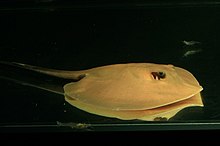Mekong freshwater stingray
| Mekong freshwater stingray | |
|---|---|

| |
| Scientific classification | |
| Domain: | Eukaryota |
| Kingdom: | Animalia |
| Phylum: | Chordata |
| Class: | Chondrichthyes |
| Subclass: | Elasmobranchii |
| Superorder: | Batoidea |
| Order: | Myliobatiformes |
| Family: | Dasyatidae |
| Genus: | Hemitrygon |
| Species: | H. laosensis
|
| Binomial name | |
| Hemitrygon laosensis (T. R. Roberts & Karnasuta, 1987)
| |
The Mekong freshwater stingray, Hemitrygon laosensis, is a
habitat degradation
.
Taxonomy and phylogeny
The Mekong freshwater stingray was first recognized as a new species by Yasuhiko Taki, who included it as "Dasyatis sp." in his 1968 list of Mekong River fishes from Laos. Taki's specimens were subsequently lost, and this ray was not formally described until 1987, by
phylogenetic analysis, based on cytochrome b sequences, found that the Mekong freshwater stingray is closely related to an undescribed dasyatid species from the Gulf of Thailand.[3]
Distribution and habitat
An exclusive inhabitant of large,
freshwater rivers, the Mekong freshwater stingray has only been recorded from sandy habitats in the Mekong River along the Laos-Thailand border, and in the Chao Phraya River near Chai Nat in central Thailand. The populations of these two rivers are likely isolated from each other.[2][4]
Description
The
papillae lie across the floor of the mouth, with the outermost pair smaller than the others. The five pairs of gill slits are short. The pelvic fins are longer than wide and triangular with rounded corners. The whip-like tail is no longer than twice the disc width and bears 1 (rarely 2) stinging spines on the upper surface. Both dorsal and ventral fin folds are found behind the spine, with the ventral fold 2.5–3 times longer than the upper fold.[2]
A single row of thorn-like
meristic counts, but differ in disc shape, denticles, and dorsal coloration.[2] The maximum known disc width of the Mekong freshwater stingray is 62 cm (24 in);[5] it can reportedly reach a weight of 30 kg (66 lb).[2]
Biology and ecology
The diet of the Mekong freshwater stingray consists of
aplacental viviparous with litter sizes possibly as small as one pup.[1]
Human interactions
The Mekong freshwater stingray is subject to intensive fishing aimed at large
Thai government initiated a captive breeding program for this and other freshwater stingray species in the 1990s at Chai Nat, but the program has since been placed on hold.[1]
References
- ^ . Retrieved 15 November 2021.
- ^ S2CID 29725251.
- .
- ^ ISBN 92-5-103743-4.
- ^ Froese, Rainer; Pauly, Daniel (eds.) (2009). "Dasyatis laosensis" in FishBase. December 2009 version.

